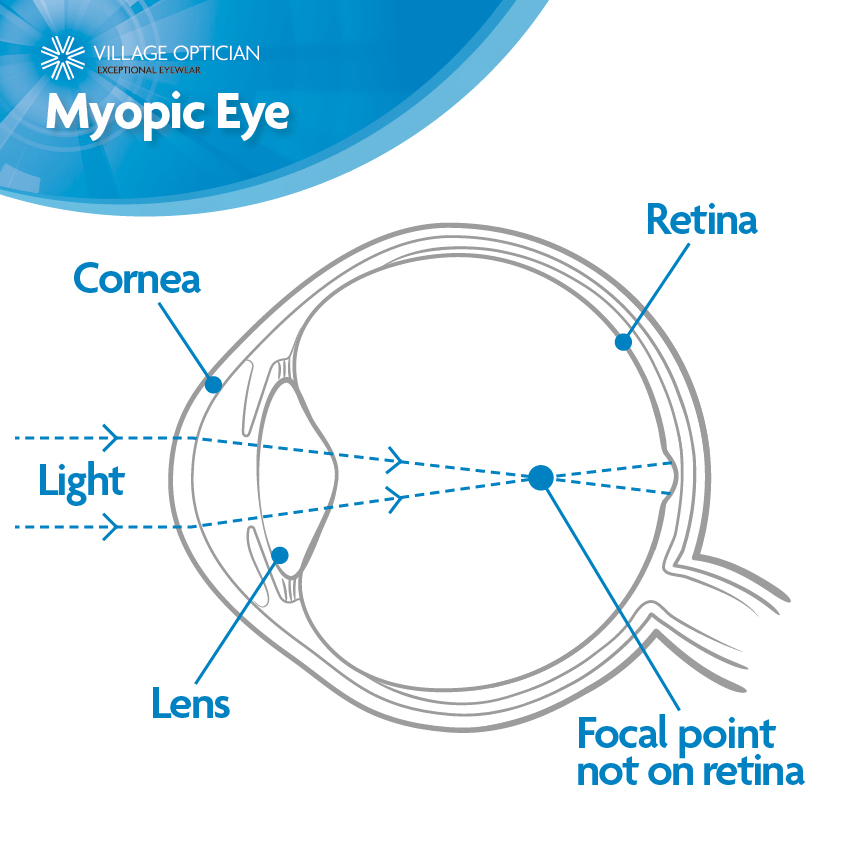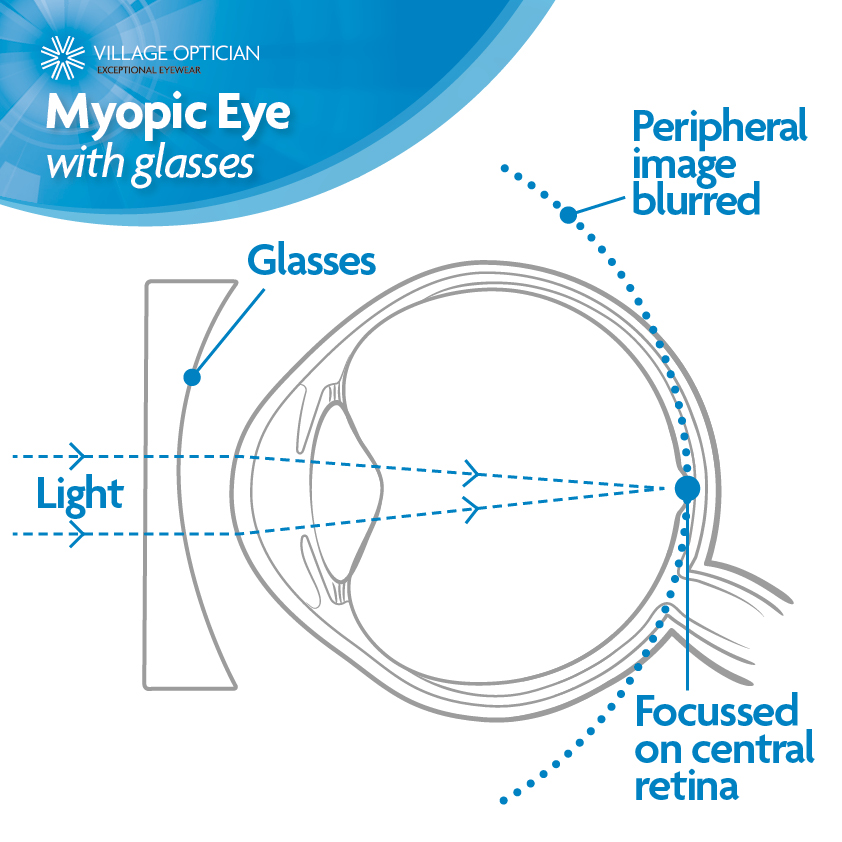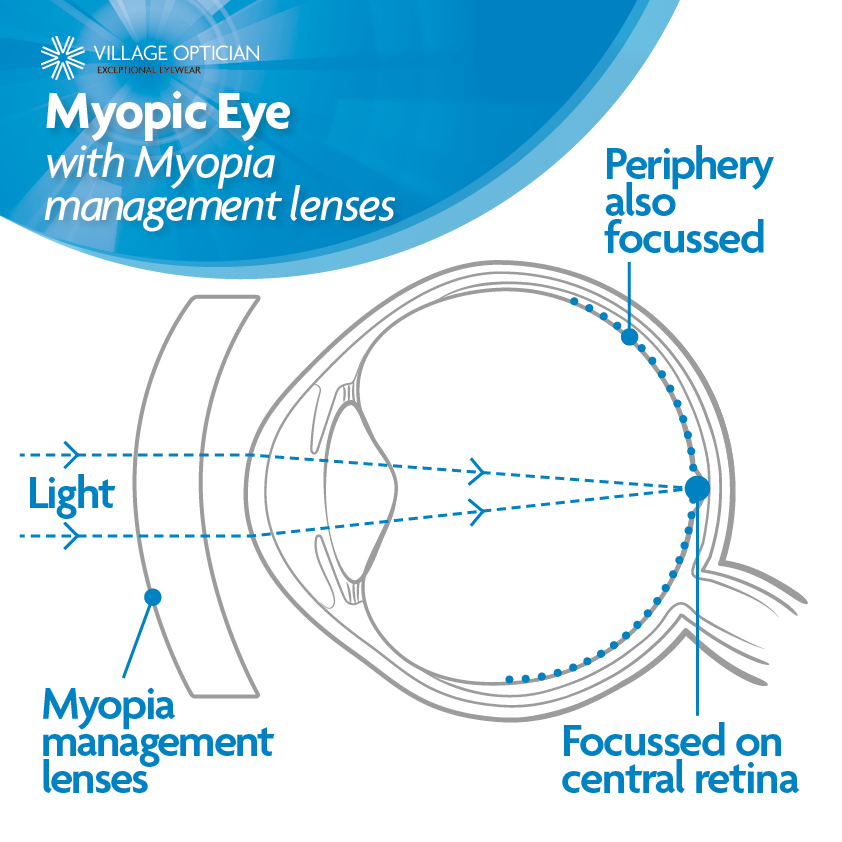Myopia is more commonly known as short sight. It means that we can't see things that are far away, but we can see things at a close distance, hence that term of being shortsighted. (In the US they call it nearsighted). That happens due to the anatomy of the eye, actually, it's down to the curves of the front of the eye and the length of the eyeball. So say for example, if that eyeball is too curved at the front, it's going to bend the light too much, so it can't focus on the back of the eye. Or if that eye is elongated and therefore a little too big, it still can't focus on the back of the eye, and it's that elongation of the eye, which is the issue.

The problem that we're facing is due to the length of the eyeball. I'll explain why in just a moment. Throughout childhood, obviously children grow, they grow very quickly, sometimes going through growth spurts. And what we usually find is if a myopic child goes through a growth spurt, their eyesight gets worse very quickly. It's that growth of that eyeball that cuases that worsening. Now, unfortunately, shortsightedness in children (myopia in children) is a worldwide problem. It is now getting worse and worse and worse. If you have shortsighted parents, myopic parents, then the child is more likely to be even more shortsighted than the parents are, and that effect is compounding generation to generation.
Now, you might be thinking, okay, well that's not a problem. We just wear glasses. That's fine, not a problem at all. But actually it's that elongation of the eyeball in very myopic eyes puts them at risk in adulthood of something called myopic eye disease. Highly myopic eyes are at risk of a form of macular degeneration, myopic macular degeneration. They are more at risk of retinal tears and detachments of the retina because of the eye being elongated and stretched so the retina is thinner. We want to try to prevent these issues now. So that's why we want to try to stop or slow down the myopic progression. Now, in the past it was a case of supplying glasses so that people could see. The good news is nowadays for children, we can now provide lenses that help to kind of manage the myopia rather than just correct the myopia.
Now, this is where myopia management glasses lenses (sometimes referred to as myopia control lenses) come into play. A lot of research has been done in the last 5 to 15 years now, and it's now becoming a mainstream thing because this actually works. The way that it works is sort of tricky to explain, (hopefully the diagrams will help), but when a spectacle lens focuses light onto the back of the eye, it's hitting the area called the macula, which is the pinpoint vision spot of the back of the eye. So therefore, you can see clearly, but you find that the peripheral parts of the vision are slightly out of focus. And that's due to the shape of the eyeball itself and the shape of the image that is put onto the back of the eye from the spectacle lens. And it's those blurred areas in the peripheral part of the vision that can still stimulate the growth of the eyeball.

It's a very strange concept that if the brain notices that things are blurred in the eye, it's more likely to grow the eye. It's trying to grow the eye to see if it finds a clear focal point, which is the opposite of what is needed as the focal point is in front of the retina, not behind it. It can't shrink the eye, but it can put growth factors into there to make the eye grow more, which actually just makes the problem worse. So myopia management lenses control that blur in the periphery, and they help to slow down the increase in myopia, which is really important. It's a strange concept because having the light focussed onto the peripheral retina can be very strange to get used to - it's actually a little blurred. This means that the lenses will give normal sharp central vision and slightly blurred peripheral vision. Children get used to this very quickly, many don't even notice that it is a little blurred at the edges. This means that the lenses will give normal sharp central vision and slightly blurred peripheral vision. The research has shown that if we can stop a child becoming just one more dioptre myopic than they would've been, that has a significant reduction in risk for myopic eye problems, myopic eye disease in adulthood. And that's just by one dioptre. So for example, if the child would've naturally become, say, -5 or -6, if the myopia management can limit that growth and the child only becomes -4, that is a huge reduction of the risk in that eyeball in adulthood of developing myopic eye problems.

So the problem with myopia progression is partly natural development in children. They can't help it. They're growing, they're growing like crazy and that growth is the problem. Now there are a few things we can do to help. Firstly close screen time. We need to limit close screen time if anything's closer than 30 centimetres, we need that further away from the children, maybe 30 minutes at a time of, of very close work. A lot of outdoor time is the best - natural light has been shown to give a chemical change in the back of the eye, which also helps to limits this growth. It slows the growth down as well, not the same way that the spectacle lens is shown to. It's a very small percentage but children who are outdoors a lot, are less likely to have myopia growth, compared to children who are indoors a lot. Unfortunately our children now are spending a lot of time indoors. There's no evidence at the moment to suggest that the screens are damaging children's eyes, but they're on screens a lot because that's the nature of life now. But it's that closeness. So if they are going play a game, (a computer game), play it on the screen further away rather than a handheld screen, that's the best advice we can give for that kind of thing.
Myopia management lenses are the best way to help to slow this down. On average, they can slow the rate of myopia down by about 60%, which is pretty good, really. Now that doesn't mean all children's myopia is going be slowed by 60%. That's an average. So some children's will be slowed by 10%, some will be by 80% or 90%. because 60% as found by the research is the overall average reduction.
There are a few other factors as to why myopia would increase in a child, such as curves in the cornea, or curves in the lens of the eye. But it's the growth that we want to slow down. So if the eye does still develop myopia, it might not be as dangerous as a growing eyeball. I hope that explains why we want to do myopia management, explains what myopia is in children and why it's dangerous, and why it's getting worse. So if you have any questions, please ask us. Hopefully this will be the start of your child's myopia management journey and we can help to slow down that progression and improve eye health in adulthood.
The NHS doesn't currently fund myopia management, so any myopia management solutions are provided on a private basis.
Our fees for myopia management glasses are;
Initial payment £150
Ongoing monthly payment by direct debit £30
Glasses replaced after 12 months under the ongoing payments.
6 monthly eye examinations (with Optomap scans) included.
CUSTOMER REVIEWS
Our number of 5 star reviews is always growing. Here is what some of our current clients have to say
We have used Village Optician for a few years now. Having tried the usual High St opticians previously, we find them very professional, friendly, nothing is too much trouble, and they take time to explain any issues. It is refreshing not to be rushed and feel pressured into buying new spectacles at every visit.
The Hudspeths
I visited the Village opticians recently and today collected my new glasses. From the first meeting with the staff to collecting my glasses what a fantastic experience everyone has been so friendly and helpful. I explained I had a problem getting a frame to fit correctly, they told me It wouldn’t be a problem they could sort it. This is the first time I have gone to collect glasses and have them fit first time also the lens they recommended are great. I saw the reviews on line before I visited this opticians and can say I agree with their comments. Your eyesight is precious and this opticians go the extra mile to make sure you receive the best treatment.
Mrs Margaret P
I have used The Village Optician for the first time and have been very impressed with the service I have received. I felt the eye test was very thorough and choosing new frames was easy as their range is extensive. Very professional and friendly service from start to finish. I highly recommend this opticians.
Angela M